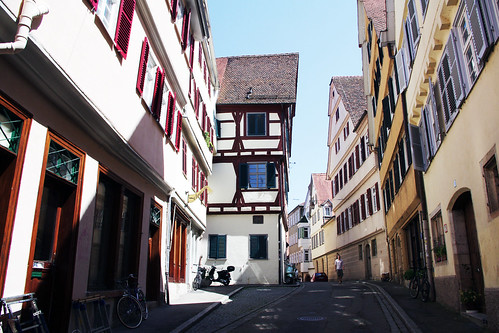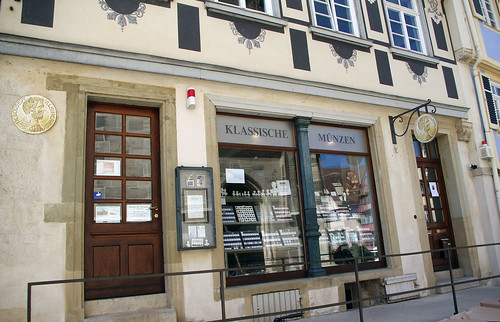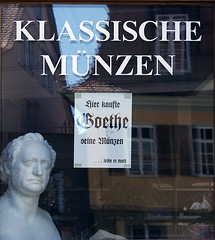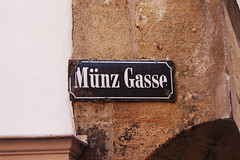
PREV ARTICLE
NEXT ARTICLE
FULL ISSUE
PREV FULL ISSUE
HOWARD BERLIN'S REPORT FROM GERMANY: GOETHE AND COIN ALLEY
Numismatourist Howard Berlin (whose book on his numismatic travels will be published soon) forward this report from Germany for E-Sylum readers. Thanks!
-Editor
I have just returned from a trip to Germany, where my wife and I attended the wedding of our oldest son to the daughter of the Bürgermeister (mayor) of a small town near Stuttgart. While there, we traveled to nearby Tübingen for a day trip to see some of the sights. The Eberhard Karls University (University of Tübingen) there, formed in 1477 is one of Europe’s oldest.
Another was that about half of the houses here on the 92 meter-long alley are timbered. Those built near the bottom of the alley near the town square are larger (for the wealthy and nobles) than those at the other end, near the St. George's Collegiate Church, were for the poorer residents.

A view of the narrow “Coin Alley” At 13 Münzgasse, there is a sign in the window, “Hier kotzte Goethe“ (Goethe vomited/puked here), probably because the writer Johann Wolfgang von Goethe is said to have spent long evenings in the local taverns here.

Dr. Brandt’s coin shop, Klassische Münzen While we were standing in front of the church, I turned around and saw a coin shop, Klassische Münzen (Classic Coins) at 15 Münzgasse (spelled on maps as one word), which is run by Dr. Michael Brandt. I wanted to go inside but, like museums in Europe on Mondays, it was closed. Although Brandt concentrates on ancient Greek, Roman, and Byzantine coins, in the store window were others of more recent vintage. This included notgeld coins from the Baden-Württemberg region, and a grouping of Kennedy half dollars There was one interesting item about this building, however. There is a stone plaque on the side of the building that translates as: “Cotta House. Goethe lived here. September 7-16, 1797.” (Johann Friedrich Cotta was the major publisher of German classicism) Also in a second story window is a sign next to a small bust of Goethe that reads: “Goethe purchased his coins here… he was still living.”


Wayne Homren, Editor The Numismatic Bibliomania Society is a non-profit organization promoting numismatic literature. See our web site at coinbooks.org. To submit items for publication in The E-Sylum, write to the Editor at this address: whomren@gmail.com To subscribe go to: https://my.binhost.com/lists/listinfo/esylum All Rights Reserved. NBS Home Page Contact the NBS webmaster 
|
